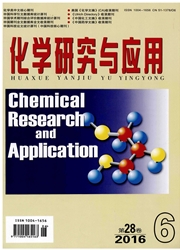

 中文摘要:
中文摘要:
以对羟基苯甲酸和正丁醇为原料、Dawson结构磷钨酸(H6P2W18O62·13H2O)为催化剂,催化对合成对羟基苯甲酸正丁酯,并对催化剂进行Py-IR、NH3-TPD表征。通过正交实验考察了各因素对酯收率的影响,探索了反应机理。Py-IR结果显示催化剂同时具有Brnsted酸中心和Lewis酸中心,NH3-TPD证实催化剂表面存在弱酸、中强酸和强酸位,其中中强酸位所占比例最大。实验结果表明:酯化催化反应同时发生在Brnsted酸中心和Lewis酸中心上,H6P2W18O62·13H2O具有较好的催化活性。当反应温度为125℃,反应时间为3.0h,催化剂用量为4.9%(基于反应物总质量),醇酸摩尔比为2∶1时,产物分离收率达91.3%。催化剂重复使用5次,产物收率仍可达70.3%。H6P2W18O62·n H2O替代硫酸作催化剂,既提高了产物的收率和纯度,又简化了工艺流程,减少了环境污染,催化剂经简单处理即可重复使用。
 英文摘要:
英文摘要:
Preparation of n-butyl p-hydroxybenzoate by the esterification of p-hydroxy benzoic acid and n-butanol using dawson structure phosphotungstic acid as catalyst was reported. The catalyst was characterized by Py-IR and NH3-TPD. The main influential factors of reaction were investigated by orthogonal experiments and the possible reaction mechanism was discussed. Py-IR results showed that both Bronsted(B)acid sites and Lewis(L)acid sites co-exist on the surface of the catalyst. The results of NH3-TPD suggested that the catalyst possessed weak,medium and strong acid sites,among which the medium acid sites accounted for the lar-gest proportion. The results obtained indicated that the esterification reaction was a Br? nsted acid-Lewis acid cooperativity catalytic reaction. Dawson structure phosphotungstic acid possessed a fairly high catalytic activity for the esterification reaction. The optimal condition could be listed as follows:the best reaction temperature was 125℃,the reaction time was 3. 0 h,the mass ratio of the cata-lyst to total reactants was 4. 9%,and the molar ratio of n-butyl alcohol to p-hydroxyl benzoic acid was 2∶1. Under these conditions, the yield of butyl p-hydroxyl benzoate could reach 91. 3%, and it was still over 70. 3%when the catalyst was reused for five times. The primary advantage of replacement of sulphuric acid to dawson structure phosphotungstic acid might be not only as the im-provement of yield and selectivity,but also the simplification of the process and the reduction of environmental pollution. The cata-lyst could be used repeatedly after being treated simply.
 同期刊论文项目
同期刊论文项目
 同项目期刊论文
同项目期刊论文
 Clean Oxidation of Cyclohexanone to Adipic Acid Catalyzed by Ammonium Phosphomolybdate with Dawson s
Clean Oxidation of Cyclohexanone to Adipic Acid Catalyzed by Ammonium Phosphomolybdate with Dawson s 期刊信息
期刊信息
